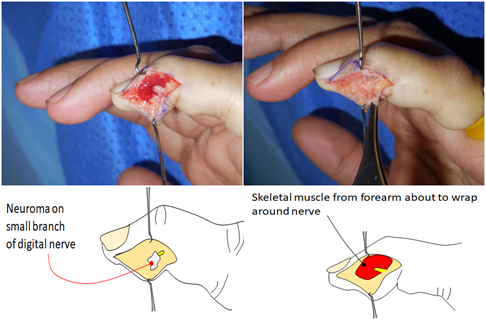Regenerative peripheral nerve interface (RPNI)
Get in touch
Not every amputee is suitable for targeted muscle reinnervation (TMR) surgery or wants to undergo this type of surgery. Some amputees, with neuroma pain (NP) and phantom limb pain (PLP) want to undergo a less invasive procedure. In these cases, Relimb™ is able to offer an alternative procedure called a Regenerative Peripheral Nerve Interface (RPNI).
RPNI is essentially a mini-TMR procedure. It uses non-vascularised pieces of muscle (typically) taken from the lateral thigh and wraps the muscle around the end of the neuroma. By doing this, the nerve fibres are encouraged to innervate the muscle (which revascularizes by vessel in-growth from the surrounding tissues) and this helps to reduce the sensitivity of the nerve end. RPNI is not as effective as TMR in terms of relief of NP or PLP but in patients with an isolated neuroma in an area with limited muscle targets (e.g. a fingertip) it can be very effective.

Length of Stay
Patients undergoing RPNI surgery alone (i.e. not in combination with Osseointegration) will generally go home on the same day as surgery. The only exception is for patients with a very high transhumeral or through-shoulder amputation where it is likely that they will need to have exploration of their brachial plexus. Such patients will need to be admitted overnight for pain control.
Pain Control
Patients undergoing RPNI surgery alone will need to take all their normal pain medications before surgery and can expect a significant increase in their PLP which may be maximal at 3 – 6 months after treatment. We advise patients to increase medications such as pregabalin in line with symptoms – as required. The actual pain of surgery is usually minimal and easily controlled with simple analgesics or mild opiates for a few days.
Wound Care
After RPNI surgery, your primary incision will be closed (typically) with absorbable sutures which do not need to be removed. There will be an additional incision over your thigh (or forearm) for harvest of the muscle grafts used for the RPNI procedure. You may wash and shower with running water immediately after surgery but should avoid any heavy use of the treated limbs for 2-3 weeks. Importantly, you must not use your prosthesis until your wounds have healed (3 weeks) and any associated soft-tissue swelling has resolved.
You do not need to have any specific rehabilitation after an RPNI procedure when this is performed for relief of pain.
